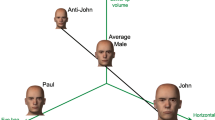Abstract
Near where you live, there may be a park with one or more statues or busts of famous people. Take a trip there, or to a museum where photography is allowed. Stand in front of the statue and, first, take a photograph of the depicted person from the front, as shown in this photo.
All photos in this section © Lasse Hodne
You have full access to this open access chapter, Download chapter PDF
Similar content being viewed by others
Near where you live, there may be a park with one or more statues or busts of famous people. Take a trip there, or to a museum where photography is allowed. Stand in front of the statue and, first, take a photograph of the depicted person from the front, as shown in this photo.

Then move to the right and take at least one photograph of the same statue from a different angle (but the same eye level), roughly as shown in this image:

Then move to the left and take one or more photos from corresponding angles:

You print the pictures you have taken on a normal printer. Then find a board made of wood or another material, on which the pictures are taped in this way:

The board must be large enough for the pictures to be attached next to each other. What does the series look like? About like this?.

You will probably agree that a bust of a person looks something like this if you move in front of it and study it from different angles. The depicted man, who is looking straight ahead, will only have eye contact with the viewer provided that the viewer is directly in front. There will be no eye contact from any other angle.
However, the question is whether we will experience a flat image in the same way? Both flat and three-dimensional objects change with changing viewing angle, but not in the same way. So, let’s imagine that this portrait was not a three-dimensional sculpture, but a photograph. (After all, we are dealing with photographs; photographs of busts.) We then start from the first image that we printed out and affixed to the plate above, and then take a photograph of the photograph, first from the front… .

… and then from an oblique angle:

This way we can create a new series and it looks like this:

There is still a difference between the photographs taken from the front and those taken from the side, but the difference is not as great. Those photographed at an angle are only slightly narrower. And what about the look? Which of these images makes eye contact with us?
Now consider what was said in the chapter about Ptolemy and Mesarites. Is it any wonder that some people found this effect mysterious?
Author information
Authors and Affiliations
Corresponding author
Editor information
Editors and Affiliations
Rights and permissions
Open Access This chapter is licensed under the terms of the Creative Commons Attribution 4.0 International License (http://creativecommons.org/licenses/by/4.0/), which permits use, sharing, adaptation, distribution and reproduction in any medium or format, as long as you give appropriate credit to the original author(s) and the source, provide a link to the Creative Commons license and indicate if changes were made.
The images or other third party material in this chapter are included in the chapter's Creative Commons license, unless indicated otherwise in a credit line to the material. If material is not included in the chapter's Creative Commons license and your intended use is not permitted by statutory regulation or exceeds the permitted use, you will need to obtain permission directly from the copyright holder.
Copyright information
© 2024 The Author(s)
About this chapter
Cite this chapter
Hodne, L. (2024). Unit 2 Lab: Portraits as Faces. In: Balinisteanu, T., Priest, K. (eds) Neuroaesthetics. Palgrave Macmillan, Cham. https://doi.org/10.1007/978-3-031-42323-9_7
Download citation
DOI: https://doi.org/10.1007/978-3-031-42323-9_7
Published:
Publisher Name: Palgrave Macmillan, Cham
Print ISBN: 978-3-031-42325-3
Online ISBN: 978-3-031-42323-9
eBook Packages: Behavioral Science and PsychologyBehavioral Science and Psychology (R0)




